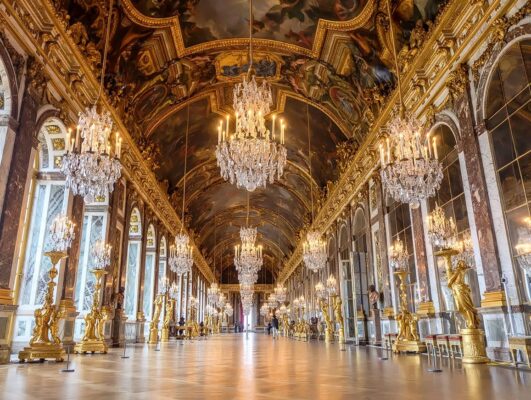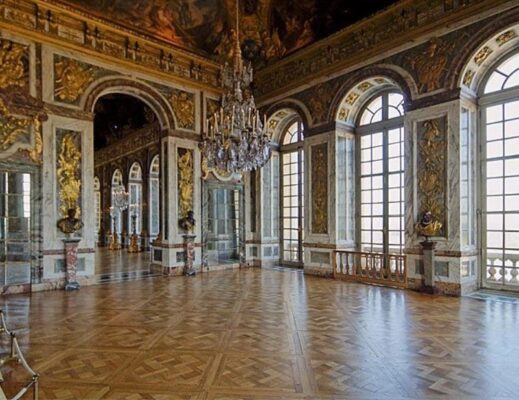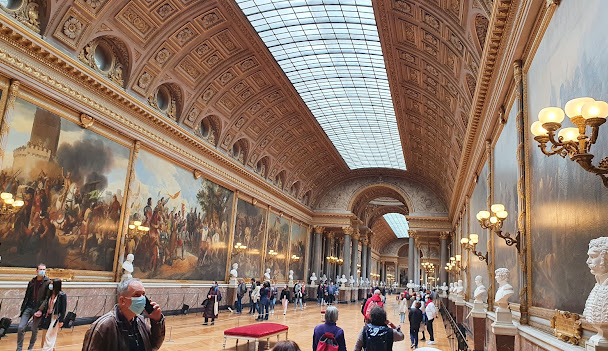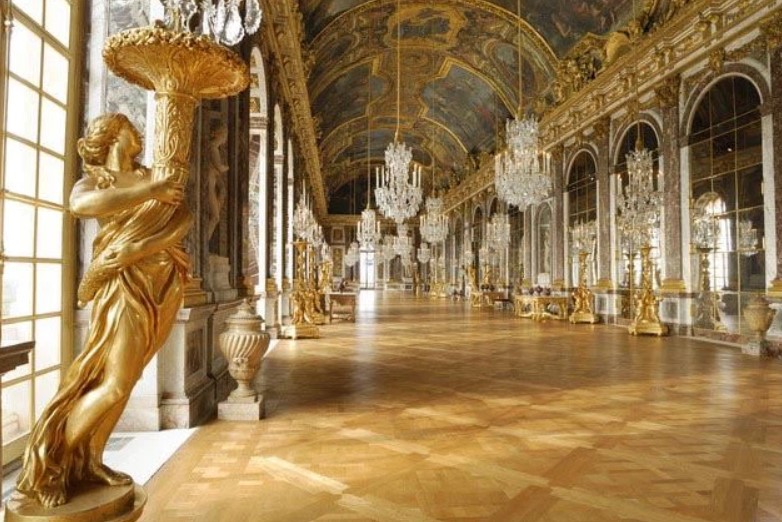The Hall of Mirrors, located in the iconic Palace of Versailles, is arguably the most famous and breathtaking room in the entire estate. Known for its opulence and architectural brilliance, this stunning gallery reflects the grandeur of the Sun King, Louis XIV, and the height of French Baroque art and design. Follow archeology.dulichvn.net to discover many hidden mysteries that have yet to be discovered.

The Architectural Splendor of the Hall of Mirrors
Impressive Dimensions and Awe-Inspiring Design
Spanning an astonishing 73 meters in length and 12 meters in height, the Hall of Mirrors is undeniably the architectural centerpiece of the Palace of Versailles. Its elongated form, flanked by the War Room at one end and the Peace Room at the other, creates a seamless transition between these spaces, emphasizing its symbolic and functional importance. Designed under the guidance of Jules Hardouin-Mansart, the hall embodies the grandeur and meticulous planning of Louis XIV’s vision of absolute monarchy.
Beyond its structural brilliance, the gallery was intended to inspire awe and reverence in all who walked through it. Its design not only highlighted the wealth and power of the French monarchy but also reflected the cultural sophistication of 17th-century France, solidifying the Hall’s role as a ceremonial space for diplomacy, celebration, and prestige.
Ceiling Masterpiece: The Triumphs of Louis XIV
The vaulted ceilings of the Hall of Mirrors are a canvas for the extraordinary talent of Charles Le Brun, the first painter to Louis XIV. Le Brun’s series of 30 frescoes meticulously illustrate the military, political, and diplomatic successes of the Sun King, celebrating his reign as a period of unparalleled dominance.
Each panel tells a story, from victories in battles to the consolidation of French territories, embodying the monarch’s divine right and near-mythical status. Rich hues of gold, blue, and crimson, combined with dynamic figures and intricate details, bring the Baroque style to life. The use of allegory and symbolism, such as gods, heroes, and celestial motifs, elevates these paintings into a timeless testament to the king’s ambition and achievements.
Le Brun’s artistry was not merely decorative; it served to reinforce the propaganda of the monarchy, showcasing Louis XIV as a ruler chosen by the divine, destined to lead France to glory.
Luxurious Materials and Dazzling Mirrors
Few spaces in the world can rival the opulence of the Hall of Mirrors. The 357 mirrors that line the gallery were a staggering innovation at the time, as mirrors were among the most expensive and rare commodities in 17th-century Europe. Positioned across 17 grand arches, each containing 21 mirrors, they reflect the sunlight streaming through the opposing windows, creating a radiant interplay of light and space. This illumination enhances the grandeur of the room, making it appear even larger and more magnificent.
The walls, clad in richly veined marble, serve as a regal backdrop for the gilded sculptures and pilasters that adorn the space. These sculptures, crafted with exquisite detail, depict motifs of strength, power, and abundance, echoing the themes of the ceiling frescoes. The gilded reliefs separating the mirrored arches further amplify the sense of wealth, transforming the hall into a symbolic representation of Louis XIV’s opulent reign.
The combined effect of light, reflection, and luxury creates an atmosphere of unparalleled magnificence, cementing the Hall of Mirrors as one of the most iconic and influential interiors in architectural history.
In every detail—from its monumental dimensions to its artistic and material richness—the Hall of Mirrors is a masterpiece that captures the spirit of Louis XIV’s France, standing as a lasting symbol of royal power, artistic excellence, and architectural ingenuity.

Historical Functions of the Hall of Mirrors
A Space for Courtly Life
The Hall of Mirrors was not just an architectural marvel; it was also a vibrant hub of daily activity for the royal court during the reign of Louis XIV. Serving as a grand promenade, it provided courtiers with a luxurious space to walk, converse, and socialize against a backdrop of unparalleled splendor.
As they strolled through the gallery, courtiers could admire the reflective beauty of the 357 mirrors, marvel at the grandeur of the ceiling frescoes, and bask in the glow of natural light streaming through the expansive windows. This space was not only a place to see and be seen but also a stage for political maneuvering, where alliances were forged, favors were sought, and the intricate hierarchy of the royal court was meticulously observed.
A Venue for Ceremonial Events
Though primarily a place for courtly life, the Hall of Mirrors occasionally transformed into a venue for major royal ceremonies. Its grandeur made it the perfect setting for princely weddings, state receptions, and other celebrations that showcased the monarchy’s power and wealth.
One of the most famous events held here was the wedding of the Dauphin, Louis XVI, to Marie Antoinette in 1770. The hall’s dazzling mirrors and opulent decorations provided an unforgettable backdrop to these grand occasions, reinforcing the monarchy’s image of absolute magnificence.
Moreover, these events were not solely for spectacle; they often carried significant political or diplomatic weight, serving as opportunities to strengthen ties between France and other European powers. The Hall of Mirrors became synonymous with the grandeur and authority of the French monarchy, enhancing its role as a setting for historical milestones.
A Stage for Diplomacy
Beyond its ceremonial and courtly functions, the Hall of Mirrors has played a critical role in European history. Its most famous diplomatic moment came on June 28, 1919, when the Treaty of Versailles was signed in this very gallery. This treaty formally ended World War I, marking a pivotal moment in modern history.
The choice of the Hall of Mirrors for such a momentous occasion was deeply symbolic. It represented the culmination of centuries of French influence and served as a reminder of Louis XIV’s ambition to project French power across Europe. At the same time, the signing of the treaty underscored the hall’s transformation from a symbol of absolute monarchy to a venue where the fate of nations was decided.
The Hall of Mirrors remains an enduring symbol of diplomacy, serving as a reminder of its role in shaping global history. Its legacy as both a cultural and political stage ensures its place as one of the most iconic spaces in European heritage.

Cultural and Symbolic Significance
Reflection of Royal Power
The Hall of Mirrors was far more than an architectural marvel; it was a deliberate and masterful expression of absolute monarchy and the unrivaled authority of Louis XIV, the Sun King. The gallery’s dazzling mirrors symbolized Louis’s ability to project his power and influence throughout his kingdom, much like the sun illuminating the earth.
The alignment of the mirrors with the hall’s expansive windows allowed sunlight to flood the space, creating an ethereal glow that seemed to embody the king’s divine right to rule. This interplay of light and reflection was not merely aesthetic but also symbolic, reinforcing the idea that Louis XIV was the central force in France, much like the sun was the center of the universe in the heliocentric model. The mirrors became a metaphor for the king’s role as a guiding light for his people and a reflection of his magnificence.
A Representation of Innovation
At a time when mirrors were an incredibly rare and expensive luxury, the Hall of Mirrors represented a bold technological and artistic statement. The gallery featured 357 mirrors, each a testament to the advancements in glass-making techniques perfected in France during the 17th century.
The production of these mirrors was itself a political triumph. Louis XIV famously sought to break Venice’s monopoly on mirror production by attracting Venetian artisans to France, a move that solidified France’s dominance in both craftsmanship and economic ingenuity. The extensive use of mirrors in the hall showcased not only technological innovation but also the ambition of a nation striving for supremacy in art, science, and industry.
The hall’s reflective surfaces also created an interactive experience for visitors, amplifying the grandeur of the space and immersing them in an atmosphere of wonder and sophistication. This ingenuity underscored France’s ability to lead the world in luxury, design, and innovation.
A Testament to French Art and Craftsmanship
The Hall of Mirrors is a masterpiece of French Baroque art and craftsmanship, embodying the artistic achievements and cultural dominance of Louis XIV’s reign. Every detail, from the marble walls to the gilded sculptures, was meticulously designed to convey elegance, power, and refinement.
The hall’s crowning glory is the series of ceiling frescoes painted by Charles Le Brun, which depict the triumphs of Louis XIV in vivid detail. These paintings are more than decoration—they are a visual narrative celebrating the king’s military, political, and diplomatic victories. The dynamic compositions, allegorical figures, and vibrant colors of Le Brun’s work exemplify the height of French artistic excellence.
The marble used in the walls was sourced from quarries across France, while the golden reliefs and sculptures were crafted by the nation’s most skilled artisans. Together, these elements demonstrate the collaborative artistry of architects, painters, sculptors, and craftsmen, all working to realize the Sun King’s vision of magnificence.
The Hall of Mirrors remains a monument to France’s artistic and cultural preeminence during the Baroque period, a space where every facet reflects the ambition, ingenuity, and artistry of an era defined by Louis XIV’s rule.
See more: The Gundestrup Cauldron: A Marvel of Celtic Art and Culture
Conclusion
The Hall of Mirrors is more than just a room; it is a masterpiece of art, architecture, and history. From its awe-inspiring design to its historical significance, it remains a symbol of French grandeur and a testament to the ambition and power of Louis XIV. Visitors to the Palace of Versailles continue to be captivated by its splendor, ensuring its legacy endures as one of the most celebrated achievements of human creativity and royal extravagance.


CÁC TIN KHÁC
Mary Walton: The Forgotten Inventor Who Helped Clean Up America’s Cities
Tomb of Queen Nefertari in the Valley of the Queens, Egypt
Discover the Hypostyle Hall of the Temple of Hathor at Dendera
Venus de Losange: Unveiling the Mystery of a 20,000-Year-Old Paleolithic Icon